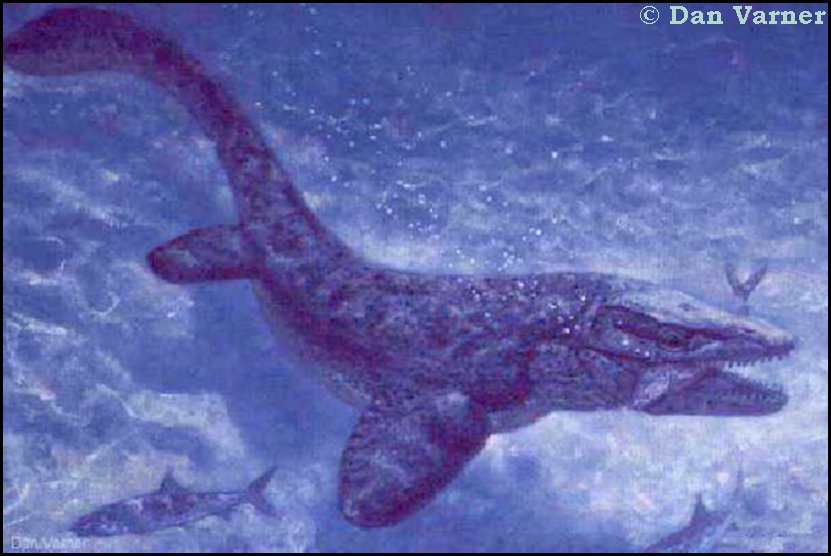
A PLIOPLATECARPUS MOSASAUR FROM THE LATE CRETACEOUS GULF COAST
Copyright © 1999-2009 by Mike Everhart
Last updated: 09/07/2009
Copyright © Dan Varner; used with permission of Dan Varner
 |
A PLIOPLATECARPUS MOSASAUR FROM THE LATE CRETACEOUS GULF COAST
Copyright © 1999-2009 by Mike Everhart Last updated: 09/07/2009
Copyright © Dan Varner; used with permission of Dan Varner |
The above picture is Dan Varner's vision of a Plioplatecarpus mosasaur feeding on bonefish along the ancient Gulf Coast of eastern North America. It was based on the 1996 discovery of a partial skeleton in the Demopolis Chalk near Selma, Alabama by a Historical Geology class from Okaloosa Walton Community College in Northwest Florida.
EDITOR'S NOTE: I had been in contact via email with Susan Erickson for the a couple of years discussing the preparation of mosasaur remains from Late Cretaceous gulf deposits in Alabama. As a result, she provided me with some pictures and the story behind the discovery. By happy coincidence, I had also obtained a 1991 Master's thesis written by David Burnham in regard to a very similar mosasaur from the same area in Alabama. The information from these two sources seemed to warrant a new webpage on Oceans of Kansas Paleontology. As it turned out, Susan told me it was the college that had commissioned Dan Varner to do the picture at the top of this page.
Susan wrote, "The class found the mosasaur by chance on an April 1996 field trip (to Alabama). Usually they go to Shell Creek which is full of Exogyro's, but since there was an unusual amount of rain that Spring they went to an cow pasture and stumbled across the mosasaur. Initially, they found some vertebrae and rib pieces, and some vertebrae from another size mosasaur. Amy Sheldon said they looked like a juveniles. The class brought back the bones which were laying on top of the ground. Dr. Jon Bryan at Okaloosa Walton Community College recognized them as mosasaur vertebrae."
"We returned in May and did more excavating. We decided that we would need a weekend to plaster jacket the skull. Dr. Bryan returned the next weekend with some students and applied a plaster jacket. The specimen was then taken back to the lab."
"I really didn't get involved until it seemed everyone else got tired of trying to piece it together. I started working on it during the summer of 1996 and was hooked immediately. I not only wanted to clean the bones .........I wanted to know what this creature looked like. That started my quest for knowledge about mosasaurs. Dr. Bryan and Ms. Williams (both invertebrate paleontologists) encouraged me to continue learning and included me in many projects. I discovered that my main interest is prep work and, fortunately, that I have infinite patience."
The following is a quote from the acknowledgments Dr. Jon Bryan wrote for the exhibit.
"OWCC geology instructor Ms. Mona Williams, led the initial trip field trip to the site and recognized the importance of the discovery. OWCC students on the first trip included (alphabetically): (left out pending permission for use of the names). Special thanks are due to Ms. Susan Erickson, who did the lion's share of the preparation of the skull. Susan has quickly become an accomplished paleontological preparator. Most of the teeth in the skull, for example, are casts that were prepared from the originals by Susan. Also, Ms. Patricia Allen was tireless in her help with cleaning and preparing the bones, in the field assistance, and the preparations for the final display."
 |
A drawing of the reconstructed skull of a Plioplatecarpus mosasaur from David Burnham's Masters thesis at the University of New Orleans: "A new mosasaur from the Upper Demopolis Formation of Sumter County, Alabama." 1991. Illustration courtesy of David A. Burnham. Copyright ©1999, All Rights Reserved, Fossilworks, Inc. |
| A composite picture showing a dorsal view of the frontal and parietal from both David Burnham's Plioplatecarpus (line drawing), and the OWCC specimen (B/W photo). Illustrations courtesy of David A. Burnham. Copyright ©1999, All Rights Reserved, Fossilworks, Inc. |  |
| A composite picture showing a ventral view of the frontal and parietal from both David Burnham's Plioplatecarpus (line drawing), and the OWCC specimen (B/W photo). Illustration courtesy of David A. Burnham. Copyright ©1999, All Rights Reserved, Fossilworks, Inc. |  |
 |
A drawing by David Burnham of the reconstructed Plioplatecarpus specimen (UNO 8611-2) showing the general proportions of the mosasaur. Scale = 1 meter. Illustration courtesy of David A. Burnham. Copyright ©1999, All Rights Reserved, Fossilworks, Inc. |
 |
A fleshed out version of David Burnham's Plioplatecarpus by Berislav Krzic, Copyright ©1999 by Berislav Krzic, All Rights Reserved by Illustrissimus Productions. For more of Beri's artwork, check out his Dinosaur Illustrated Magazine |
| This map shows the general extent of the Demopolis formation in Mississippi and Alabama. This formation represents marine sediments deposited along eastern edge of the Mississippi Embayment during the Cretaceous Period. The UNO specimen comes from near the top of the Demopolis chalk and is of latest Campanian age (about 71 million years old). Illustration courtesy of David A. Burnham. Copyright ©1999, All Rights Reserved, Fossilworks, Inc. |  |
See a Kansas Plioplatecarpus: A new mosasaur from Kansas.
Burnham, David. 1991. A new mosasaur from the Upper Demopolis Formation of Sumter County, Alabama. Masters thesis, University of New Orleans, 63 pp.
Holmes, Robert, Plioplatecarpus primaevus (Mosasauridae) from the Bearpaw Formation (Campanian, Upper Cretaceous) of the North American Western Interior Seaway, Journal of Vertebrate Paleontology, 16(4):673-687, 1996
